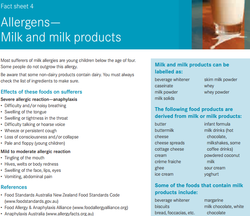This information may be useful to follow if you have a complaint about food safety in your business.
Download this document here.
| ✓ Correct Training Systems |
|
|
Queensland health has guidance on how to handle a food safety complaint.
This information may be useful to follow if you have a complaint about food safety in your business. Download this document here. This checklist has been designed to assist food businesses make a self-assessment of their level of compliance with the Food Safety Standards. It was developed in consultation with various industry representatives and is suitable for use by all businesses involved in the handling, storing, and sale of food in Queensland including food retailers, food service and take-away food businesses, catering, manufacturing and transporters of food.
https://publications.qld.gov.au/dataset/food-act-compliance-information-for-businesses/resource/915e72c1-120d-495b-b6a3-c14476ae17e_0  Victoria Health has an excellent information fact sheet on each allergen listing common foods where each allergen is found. Be more aware of allergens in your products. Download your copy here. Victoria Health has a guidance document on practices to keep food safe for class 2 food businesses in Victoria. This useful document provides guidance on procedures to follow when:
This guide explains the temperature control requirements in Food Safety Standard 3.2.2 Food Safety Practices and General Requirements and provides some advice on how to comply with the requirements applied to Potentially Hazardous Foods.
http://www.foodstandards.gov.au/publications/documents/FSTemp_control_Edition_for_printing.pd_f Potentially hazardous food has a legal definition in Standard 3.2.2 Food Safety Practices and General Requirements. It means food that has to be kept at certain temperatures to minimise multiplication of any food-poisoning bacteria that may be present in the food or to prevent the formation of toxins in the food. Download this guidance material here:  Queensland Health has a simple factsheet outlining the responsibilities of a food business, and the responsibilities of food handlers for personal health & hygiene.
The Queensland Health Department has a simple fact sheet reminder of the food safety procedures to follow when handling ice.
Download the unit of competency for the Food Safety Supervisor qualification using SIRRFSA001A unit from the Retail Industry training package. This outlines the content and requirements of the unit to be achieved.
Simple instructions from the NSW Food Authority on how to calibrate thermometer probes- hot and cold temperatures.
From Food Safety Guidelines for the preparation of raw egg products. NSWFA Foods that contain raw or lightly-cooked egg are often used in food service and retail businesses. Menu items that have raw and lightly cooked eggs as ingredients need extra care, as they can cause food poisoning if not handled correctly.
Large foodborne illness outbreaks have been associated with foods made from raw eggs including:
Alternatives include commercially produced dressings and sauces, or pasteurised egg product. If your business continues to use raw eggs in menu items that are not or lightly cooked then these items require particular care, following the guidelines for safe preparation of raw egg products. Egg safety in a particular focus area for the NSW Food Authority because of its link to Salmonella food poisoning instances. Please use the resources of the NSW Food authority to manage you safe use of eggs within your business. In 2012 NSW made it a requirement for businesses that had 20 or more outlets in NSW or 50 or more in Australia to provide nutrition ( kilojoule information) on standard menu items. This initiative is being promoted to consumers as 8700.com.au
Standard food outlets must display the following nutrition information: • the average kJ content of each standard food item for sale by the standard food outlet, expressed in kilojoules (kJ), and • the reference statement ‘The average adult daily energy intake is 8700 kJ’. For further information review the information on the NSW Food Authority website or guideline here
Australia has Food Safety Standards that apply to all food business.
These are: 3.2.1 Food Safety Programs 3.2.2 Food Safety Practices and General Requirements 3.2.3 Food Premises and Equipment Some food businesses also have additional mandatory standards or voluntary Customer/ Supplier standards to comply with, such as import and export approved arrangements, HACCP certification, and Global food standards such as BRC, SQF, ISO22000. Food businesses also have specific responsibilities relating to: 1.Prevent contamination of food 2.the health of people who handle food, 3.the provision of hand washing facilities, 4.making food handlers aware of their health and hygiene obligations 5.Protect the privacy of food handlers Download CTS's summary of food safety program and responsibilities here. This guide provides an simple introduction into the principles of food safety. Although aimed at domestic consumers the information is sound and applicable to most food businesses. An excellent introduction to food safety. https://www2.health.vic.gov.au/about/publications/policiesandguidelines/Your%20Guide%20to%20Food%20Safety. Download the file here for pre reading to our Food Safety Supervisor Course or Implement HACCP Food Safety Systems training course.
This is a guideline document to Standard 3.2.2 Food Safety Practices and General Requirements. This Standard sets out specific requirements for food businesses and food handlers that, if complied with, will ensure food does not become unsafe or unsuitable. This Standard specifies process control requirements to be satisfied at each step of the food handling process. Some requirements relate to the receipt, storage, processing, display, packaging, distribution disposal and recall of food. Other requirements relate to the skills and knowledge of food handlers and their supervisors, the health and hygiene of food handlers, and the cleaning, sanitising, and maintenance of premises and equipment. Download this Guideline here. This document is recommended reading for all of the CTS training programs.
This guideline prepared by the NSW Food Authority explains the mandatory requirements detailed in current legislation and the Food Standards Code 3.3.1. It covers Licencing requirements that apply; Specific issues for a food safety program for a 3.3.1 licenced facility; Menu design; Preparation and Storage of ready to eat foods( not cooked); Cook Serve foods; Cook Chill foods; Preparation of texture modified and pureed foods; preparation of infant formula; Allergen control. It acts reference material for Cook Chill food preparation, HACCP and food safety programs, and auditing facilities that prepare and serve food to vulnerable populations. This document is recommended reading for the CTS Audit a Cook Chill Process training program.
 Under the Food Standards Code, a food handler must take all reasonable measures not to handle food or food surfaces in a way that is likely to compromise the safety and suitability of food and protect food from contamination. Food handlers also have specific responsibilities relating to health and hygiene. This NSW Food Authority fact sheet outline the Health and Hygiene responsibilities. (click here) The Department of Health & Human Services has launched a new template supplement, for class 2 retail and food business who use Sous Vide practices as a method of cooking or cook chill high risk food. Food safety program template Supplementary practices section. Sous Vide. This supplement is for use with the Food Safety Program template for class 2 retail and food service businesses, No.1 version 3. The supplement outlines the requirements, and time and temperature parameters for businesses using sous vide cooking practices. This supplement template informs industry standards for Sous Vide Cooking processes and controls. This document is required reading for the CTS Audit a Cook Chill Process training program.
|
Categories/
|
||||||||||||||||||||||||||||||||||||||||||||||||||||
Correct Food Systems-
|
|